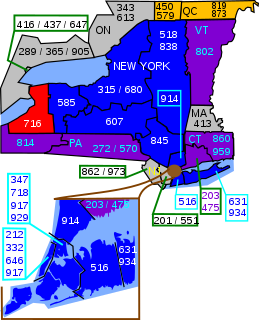 W
WBuffalo is the second-largest city in the U.S. state of New York and the largest city in Western New York. As of 2019's census estimates, the city proper population was 255,284. The city is the county seat of Erie County and serves as a major gateway for commerce and travel across the Canadian border, forming part of the bi-national Buffalo Niagara Region and Buffalo–Niagara Falls metropolitan area. As of 2018, the Buffalo-Niagara Falls metropolitan area had a population of 1,130,152; the combined statistical area, which adds Cattaraugus County, had a population of 1,215,826.
 W
WUnited States area code 716 is an area code that is used for the western area of New York, including Buffalo, Niagara Falls, and the area surrounding.
 W
W"Buffalo buffalo Buffalo buffalo buffalo buffalo Buffalo buffalo" is a grammatically correct sentence in English, often presented as an example of how homonyms and homophones can be used to create complicated linguistic constructs through lexical ambiguity. It has been discussed in literature in various forms since 1967, when it appeared in Dmitri Borgmann's Beyond Language: Adventures in Word and Thought.
 W
WColumbus Park is a park located in Buffalo, New York along Porter Avenue and Niagara Street at 641–649 Niagara St. It is one of the oldest parks in Buffalo, and lies within the Prospect Hill Historic District but is not a contributing property to the district. A statue of Christopher Columbus was added in 1952. The statue was removed on 10 July 2020. The same day, city officials announced that the Park would be renamed with no mention of Columbus. The new name will involve someone that better honors the contributions and sacrifices of Italian Americans.
 W
WThe Buffalo area economy consists of a mix of industrial, light manufacturing, high technology and service-oriented private sector companies. Instead of relying on a single industry or sector for its economic future, the region has taken a diversified approach that has the potential to create opportunities for growth and expansion in the 21st century.
 W
WThe City of Buffalo designates landmarks and historic districts to recognize and protect places of local, state, and national significance.
 W
WBuffalo consists of 31 different neighborhoods, over an area of 52 sq. mi The following is a list of neighborhoods defined by the University at Buffalo.